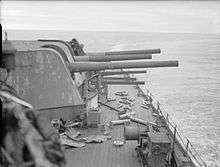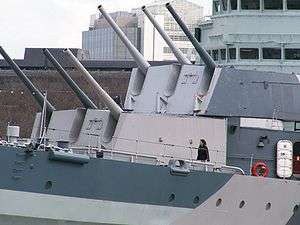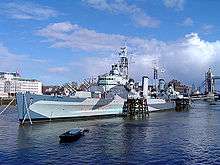Town-class cruiser (1936)
 HMS Liverpool in 1942 | |
| Class overview | |
|---|---|
| Name: | Town class |
| Operators: |
|
| Preceded by: | Arethusa class |
| Succeeded by: | Dido class |
| Subclasses: |
|
| Completed: | 10 |
| Lost: | 4 |
| Retired: | 5 |
| Preserved: | 1 |
| General characteristics | |
| Class and type: | Light cruiser |
| Displacement: |
|
| Length: |
|
| Beam: |
|
| Draught: |
|
| Installed power: |
|
| Propulsion: |
|
| Speed: | |
| Range: | 5,300 nmi (6,100 mi; 9,800 km) at 13 kn (15 mph; 24 km/h) |
| Capacity: | 1,325 short tons (1,202 t) fuel oil |
| Complement: | 750 |
| Sensors and processing systems: | Radar |
| Armament: |
|
| Aircraft carried: | 2 × Supermarine Walrus flying boats (removed in the latter part of WWII) |
| Aviation facilities: | 1 × catapult |
The Town class was a 10-ship class of light cruisers of the Royal Navy. The Towns were designed to the constraints imposed by the London Naval Treaty of 1930. The ships were built in three distinct sub-classes, the Southampton, Gloucester and Edinburgh classes respectively, each sub-class adding on further weaponry.
Armament


Like their US and Japanese counterparts of that era, the Town-class cruisers were "light cruisers" in the strict terms of the Treaty. The London Treaty defined a "light cruiser" as one having a main armament no greater than 6.1 in (155 mm) calibre, all three major naval powers sought to circumvent the limitations on heavy cruiser numbers by building "light cruisers" that were equal in size and effective power to heavy cruisers. These ships made up for their smaller calibre guns by carrying larger numbers of them.
All of these ships carried BL 6-inch Mk XXIII guns in triple turrets, with the centre gun mounted 30 in (76 cm) behind the two outer guns to prevent interference between the shells in flight and to give the gunners more room to work in.[1] The turret roofs had cutouts at the front to allow extreme elevation, originally intended to give the guns an anti-aircraft capability. In practice the guns could not be trained or manually loaded quickly enough for continuous anti-aircraft fire, so the Royal Navy designed the ABU, which allowed the guns to be preloaded with time-fuzed shells and then fired when the target aircraft reached the preset range. These ships were equipped with the HACS AA fire control system for the secondary armament and the Admiralty Fire Control Table for surface fire control of the main armament.
The secondary armament consisted of four twin XIX 4-inch turrets, and two quad pom poms.[2] Additional light antiaircraft weapons were added during the war and the 4-inch mounts were converted to RPC.[3] Postwar the Birmingham and Newcastle were partially reconstructed in 1949-51 with enclosed bridges, new lattice masts, improvement of already good surface fire control and long range radar, and an improved but still unreliable version of the Glasshouse Directors with 275 lock and follow radar, with flyplane control [4] for the Twin 4 inch guns which elevation speed was increased to 15-20 degrees per second to engage faster jet aircraft. Similar electronic alterations were made to Sheffield, but it received less structural alteration, Liverpool was put into reserve in 1952 to preserve it for potential modernisation and Glasgow minimal improvement,to allow use if required in the Suez, Middle East crisis of 1956. Birmingham, Newcastle and Sheffield had the pom pom and 20 mm armament replaced by 40mm Bofors mounts.[5] Belfast was fitted with MRS 8 HACDT to combine 40mm and twin 4 inch AA fire and capable of updating if the L70 proximity fused 40mm used by the British Army became available.
Southampton class
The Southampton class was the first and the subsequent two sub-classes were also known as modified or improved Southamptons. They had originally been built in response to the US Brooklyn and Japanese Mogami-class light cruisers.
Uniquely, the final Southampton class cruiser, HMS Birmingham, was built with a fully flared bow and is easily distinguished by the lack of the prominent knuckle found on her sister-ships. This modification was not continued in the follow-on "Gloucester" class.
Gloucester class
The subsequent Gloucesters had a redesigned deck and received thicker armour on the gun turrets.
Edinburgh class

The Edinburgh class were longer at 614 ft (187 m) compared to 592 ft (180 m), initially to allow an increase in the main armament from twelve 6 in (152 mm) guns in four triple turrets as in the two previous sub-classes, to sixteen 6 in guns in four quadruple turrets. The idea was soon shelved however, due to the difficulties in actually manufacturing an effective quadruple 6 in turret, and so the class reverted to the original main armament design, although improved through a "long trunk" Mk XXIII turret design, which reduced the crew requirements and increased the speed of the ammunition hoists.[6] Four extra 4 in (102 mm) "High Angle Low Angle" guns and eight extra 2-pounder (40 mm) guns and further armour protection were added instead.
Later improvements
All were heavily modified during the Second World War and after the Korean War; Glasgow, Sheffield and Newcastle had one aft turret replaced by two quad 40 mm Bofors guns during the Second World War, since there was insufficient space to fit the needed extra anti-aircraft guns and retain the turret. This was not a problem in the Edinburghs, because they were longer and had more room. They still had substantial modifications to their weaponry, including addition of 40 mm Bofors guns. The addition of radar equipment during the Second World War aided the ships' combat effectiveness.
Service
The first Town-class ship was launched in 1936 and commissioned in 1937, just two years before the outbreak of war. The Town class saw much service during the Second World War and took part in many famous actions, such as the sinking of the German battleship Scharnhorst. Four were sunk during the war, Edinburgh, Gloucester, Manchester, and Southampton. Many of the surviving ships saw successful service during the Korean War and continued in active service to the end of the 1950s. The last Town-class ship to be scrapped was Sheffield in 1967. One Town-class warship — Belfast — remains, moored on the River Thames in London as a museum-ship of the Imperial War Museum, a role she has performed since 1971.
Ships
| Name | Pennant | Builder | Laid down | Launched | Commissioned | Fate |
|---|---|---|---|---|---|---|
| Southampton class | ||||||
| Newcastle (ex-Minotaur) |
C76 | Vickers-Armstrongs, Newcastle | 4 October 1934 | 23 January 1936 | 5 March 1937 | Broken up at Faslane, 1959 |
| Southampton (ex-Polyphemus) |
C83 | John Brown, Clydebank | 21 November 1934 | 10 March 1936 | 6 March 1937 | Scuttled following air attack off Malta, 11 January 1941 |
| Sheffield | C24 | Vickers-Armstrongs, Newcastle | 31 January 1935 | 23 July 1936 | 25 August 1937 | Broken up at Faslane, 1967 |
| Glasgow | C21 | Scotts, Greenock | 16 April 1935 | 20 June 1936 | 9 September 1937 | Broken up at Blyth, 1958 |
| Birmingham | C19 | HM Dockyard, Devonport | 18 July 1935 | 1 September 1936 | 18 November 1937 | Broken up at Inverkeithing, 1960 |
| Gloucester class | ||||||
| Liverpool | C11 | Fairfields, Govan | 17 February 1936 | 24 March 1937 | 2 November 1938 | Broken up at Bo'Ness, 1958 |
| Manchester | C15 | Hawthorn Leslie, Hebburn | 28 March 1936 | 12 April 1937 | 4 August 1938 | Scuttled following torpedo attack off Cap Bon, 13 August 1942 |
| Gloucester | C62 | HM Dockyard, Devonport | 22 September 1936 | 19 October 1937 | 31 January 1939 | Sunk following air attack off Crete, 22 May 1941 |
| Edinburgh class | ||||||
| Belfast | C35 | Harland and Wolff, Belfast | 10 December 1936 | 17 March 1938 | 5 August 1939 | Preserved as museum ship in London |
| Edinburgh | C16 | Swan Hunter, Newcastle | 30 December 1936 | 31 March 1938 | 6 July 1939 | Scuttled following torpedo attack, 2 May 1942 |
See also
Notes
References
- Colledge, J. J.; Warlow, Ben (2006) [1969]. Ships of the Royal Navy: The Complete Record of all Fighting Ships of the Royal Navy (Rev. ed.). London: Chatham Publishing. ISBN 978-1-86176-281-8. OCLC 67375475.
- Tony DiGiulian, Britain 6"/50 (15.2 cm) BL Mark XXIII
External links
| Wikimedia Commons has media related to Town class cruiser (1936). |